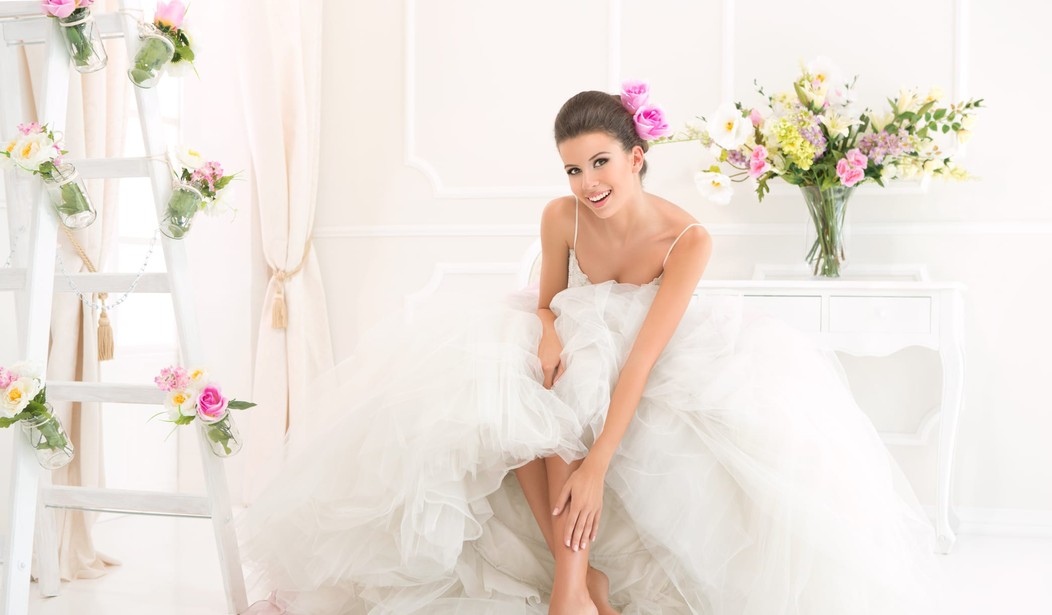NPR’s Neda Ulaby reports that “when it comes to the bridal bust line, the question these days is is ‘how low can you go?’” In a story for Morning Edition, Ulaby outlines a new trend in bridal fashion: the plunging neckline.
Ulaby spoke to Monte Durham, a wedding dress consultant and co-host of TLC’s Say Yes to the Dress, Atlanta. “How can I say this kind of politely?” Durham quips to Ulaby. “We have dresses cut to your navel.” According to Durham, ninety percent of the brides he sees want to at least try on a revealing gown.
Ulaby spoke to Patricia Arend, a sociologist who studies the wedding industry, about why brides are suddenly so focused on showing more skin. “Marriage is no longer an event that transitions a person from a child into adulthood,” Arend explains. Ulaby adds that “women getting married for the first time are on average 27 years old. In 1960 they were 22. And today more than half of couples getting married live together first.”
In other words, bridal fashion has begun to reflect the fact that the symbolism of the white dress no longer represents the bride who wears it. “Something like upwards of ninety percent of women who marry are sexually experienced and some of them are sexually experienced with other women,” says Arend. “So the reference of being this innocent person who’s going to lose her virginity on her wedding night, or something like that, and needs to be seen as pure and chaste, that is disappearing also.”
In a 2001 article for The Atlantic, Caitlin Flanagan (who, in addition to being a writer, is also my aunt) exposed the disconnect between the symbolism of opulent white weddings, and the reality of the sexual experience of most modern brides. “To stage a white wedding as the form was originally conceived requires a woman young enough that her very age suggests a measure of innocence, the still-married parents who have harbored her up to this point, and a young man of like religious affiliation who is willing to assume responsibility for her keep,” Flanagan explained. “Trying to pull off this piece of theater in light of the divorce culture, the women’s movement, the sexual revolution, and the acceptability of mixed and later marriages threatens to make a complete mockery of the thing.”
The obvious discrepancy between the sexual experience of today’s bride and the myriad symbols of virginity inherent in the traditional white wedding has, so far, been a form of cognitive dissonance most people have been willing to accept. The modern bride, Flanagan wrote, can “gratefully accept a handful of condoms from her guidance counselor and also be assured that no one will laugh when she shows up at her wedding, on her father’s arm, wearing a floor-length beaded white gown.”
In the years since Flanagan’s article was published, weddings have only become more opulent and expensive. But does the trend of plunging-necklined bridal gowns signal a further shift in the symbolism of wedding dresses? A symbolism that, perhaps, more accurately depicts the state of the modern bride? Arend speculates that these dresses “dismantle the tired old virgin/whore dichotomy.” It’s no longer unacceptable for a husband to openly find his wife sexually appealing. “They prove the girl that a guy wants to sleep with and the girl he wants to marry are exactly the same person,” Ulaby quotes Arend as saying. But if the wife is no longer the virgin, must she then be the whore?
Is a wife’s sex appeal — and her husband’s appreciation of it — a public matter? And — perhaps more importantly — ought it to be the centerpiece of a wedding? Sex has always been a part of the symbolism of weddings, but it used to be, as Flanagan wrote, because the wedding was “an occasion of tremendous moment . . . the beginning of a woman’s sexual life.” If that’s not what’s going on — if the woman’s sex life is just going to continue on as usual — shouldn’t the wedding celebrate what is new (the couple’s commitment) rather than what’s already happened?
In choosing to wear more revealing gowns, modern brides are shifting the symbolism of the wedding dress closer to the truth. If the dress is meant to signify the state of a woman’s sexual experience, then the symbolism of a low-cut dress does more accurately represent the status of most brides’ sex lives. But if a wedding no longer holds inherently within it the promise of the woman losing her virginity, then sex shouldn’t be a part of the wedding’s symbolism at all. Then the dress could just be… well, a dress.









Join the conversation as a VIP Member